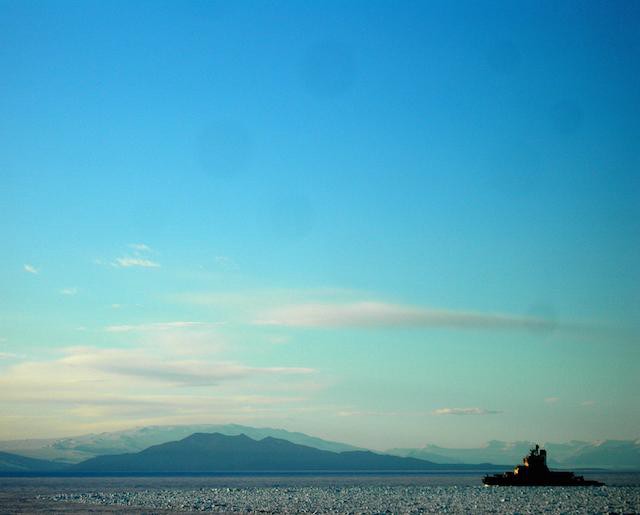The Ends
by Daniel Solomon

The path is an archaic technology; the foot that fashions it, even more so. In a so-titled travelogue, Robert Macfarlane refers to walking and its synonyms — way-faring, trekking, traversing — as one of “the old ways.” The foot progresses precisely as quickly as its body allows, and precisely as far as its terrain extends. Each step is a repetitive terraform over a jagged quarry, or a well-trod mountain trail, or a barely hardened square of urban concrete.
For Paul Salopek, paths are an artifact of humanity’s self-propelled evolution: the universal, oft-retold story of the progress of the human species from here, where we are, to there, where we were and will be. Over the past year, Salopek has walked, slowly, through one particular path of human experience — from Ethiopia, the reported square-one of the Homo sapien species, to the Jordan River Valley, his latest dateline. Sponsored in part by National Geographic, the walk is an explorer’s opus. If some walks cover a single path, constantly retread, Salopek’s covers all of them, from the original trailhead to its inevitable conclusion.
Unlike the mythic walkabout, which guided the aboriginal adolescent to nowhere in particular, Salopek’s journey bears an obvious purpose: eventually, after seven years, it ends. In 2020, at a slow, familiar three miles per hour, the pilgrimage will conclude in South America. The continent is symbolic, as all locations must be: the site of the first New World, and of its early revolutions. The southernmost tip, in Chile, of human civilization. The high-minded battleground, perhaps coincidentally, of Darwin’s evolutionary research, which so changed perceptions of the spaces and times that Homo sapiens inhabit.
Salopek’s conclusion stops short of Antarctica, an unattainable extremity for the foot-bound explorer. In a straight line, Puerto Toro, the world’s southernmost settlement, is approximately 2,425 miles from the globe’s icy southern pole. The flight between Punta Arenas, the nearest airport, and its Antarctic destination is a spot longer than three hours. Antarctica’s tourists often fly — or, more frequently, sail — through Chile, but the majority of the pole’s temporary residents — sponsored explorers, naval officers, climate scientists, cooks and mechanics and supply-truck drivers — travel through Christchurch, New Zealand. Approximately 5,500 Antarctic-bound passengers travel through Christchurch each summer, according to its airport’s website. McMurdo Station, the U.S. naval research facility that hosts Antarctica’s largest “community,” is their most frequent destination. The base was established in 1956, one year prior to the International Geophysical Year, when the international scientific community swarmed the newly habitable ice. Since then, McMurdo has become a large, tech-savvy hostel — its community returns, year after year, but never to stay.
During that monumental year, and during most years since, an American artist, also funded by the National Science Foundation, has joined McMurdo’s new settlers. During the last austral summer, the NSF’s Antarctic fellow was Jynne Dilling Martin, a poet and New York-based books publicist. Martin’s writing from McMurdo, and elsewhere across the continent, embraces the sensory shock of an unusual terrain. Its glacial architecture is a familiar feature:
“The unusual combination of salt water and fresh water vaporizing, dripping, and refreezing within the windless interior of the ice cave allows the growth of enormous and extravagant crystal shapes. The thin snow walls allow fluctuating amounts of turquoise light to shine through, and every color of blue imaginable glows all around you.”
Over the phone, Martin’s description of her experience in Antarctica is equally, if not more lyrical. Few words capture the complex texture of a simple, scarcely varied white landscape, and Martin has collected most of them. One is “palimpsest,” a manuscript annotated and revised to near-saturation. Like Salopek’s paths, the glacial text of Antarctica’s terrain is subtly, constantly retread. Here, against the foot-bound explorer’s Jordan River Valley, the human imprint is more difficult to observe. The history of the glacier’s movements, its crevasses and surfaces, its scientific Easter eggs, only recently intersects with that of its human observers. During Martin’s residency, a research team melted a glacier to uncover a thousands-of-years-old air bubble. Others trace the global journey of an aging dust-speck, whose half-life reduces the proportional duration of the Roman Empire to an infant’s momentary teething episode.
As a research subject, Antarctica defies most measurements common to the practice of terrestrial science. Martin describes a total sense of disorientation: the perception of scale recedes, as do calculations of time and direction. In Martin’s Antarctica, these dimensions only exist under the advance imprint of McMurdo’s mountaineering team, which clears researchers’ pathways through less fragile glaciers. Aside from rare familiar markers, human measurement collapses into insignificance. The distorted dimensions of a glaciologist’s subject prompt Martin’s comparison to a team of astronomers, uncovering the mysteries of a terrestrial cosmos in intentionally uncharted territory.
For all its research interest over the past seven decades, where to begin the cosmological story of Antarctica is not quite clear. Its ending is increasingly imminent. In different ways, across divergent spacetimes, Salopek and Martin are gazing at the collapse of the Holocene, an earth-bound cosmos. For Salopek, that ecosystem, so expansive in scope, crumbles in infinitesimal fragments, like the shards of a reconstructed monastery. Dwindling by approximately 1.2 percent per decade, Antarctica’s ecological destruction is a cataclysmic, even apocalyptic event. “Lost friends / return to us in dreams, but come morning we can’t recall / what they wanted.”
Daniel Solomon is a writer based in Washington, D.C. He blogs at Securing Rights. Antarctica photo by Eli Duke.
